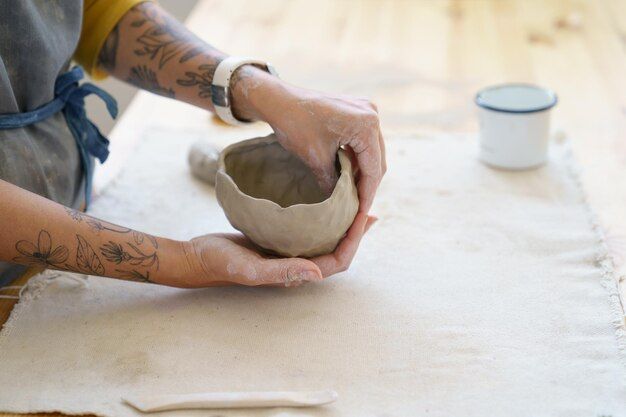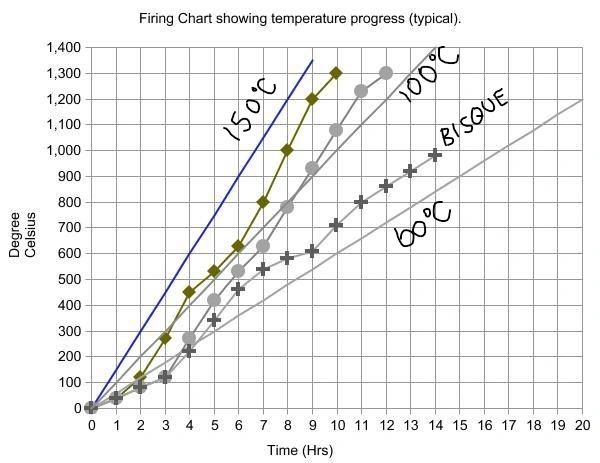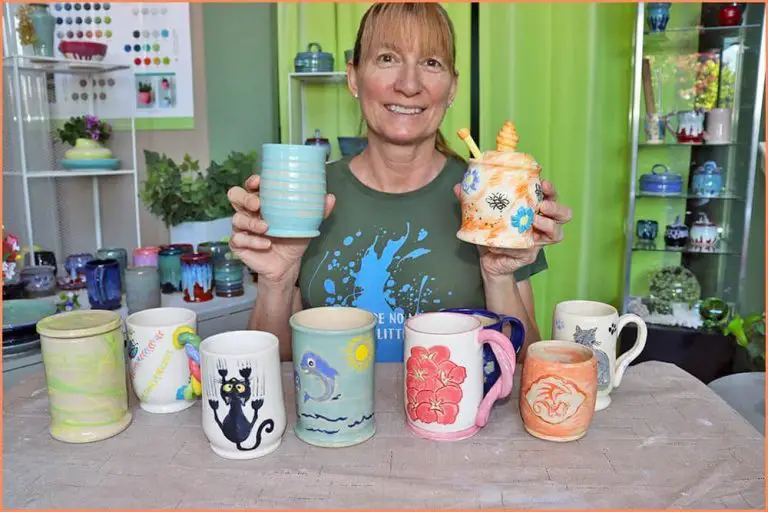What Is The Best Clay For Hand Building Pottery?
Handbuilding is one of the oldest and most fundamental techniques in pottery. It involves shaping clay by hand into functional or decorative objects without the use of a potter’s wheel. Choosing the right clay is critical for success in handbuilding. The clay must be plastic and workable enough to hold shapes without slumping or cracking, while also being strong enough to withstand handling and hold fine details.
The type of clay used for handbuilding has a significant impact on the finished results. Factors like color, texture, firing temperature, and shrinkage must be taken into account based on the needs of the project. With so many clay bodies to choose from, it can be challenging to select the ideal clay for handbuilding. This guide will examine the properties of different clays and provide tips on choosing the best clay for handbuilt pottery.
Properties of Clay
The properties of clay determine how suitable it is for handbuilding pottery. The most important properties are composition, plasticity, and drying time.(https://thepotterywheel.com/best-clay-for-handbuilding-pottery/) Clay composition refers to the minerals present in the clay which give it certain characteristics. Plasticity measures how easily the clay can be shaped without cracking or collapsing. Drying time is the length of time required for wet clay to become leather-hard.
Clays high in kaolinite tend to be more plastic and strong when dry. However, they also shrink more. Clays with lots of illite or ball clay are also quite plastic. The amounts of different minerals affect the clay’s plasticity, workability, firing temperature, and color when fired.(https://www.thecrucible.org/guides/ceramics/handbuilding/) More plastic clay is easier to handbuild with since it can be shaped without excessive cracking or slumping.
The drying time allows enough working time for shaping the clay without it drying out too fast. Earthenware and stoneware clays are better for handbuilding as they have an ideal balance of plasticity and drying time. Porcelain dries quickly and tends to crack more during shaping.
Common Clays for Handbuilding
There are three main types of clay that are commonly used for handbuilding pottery and ceramics: earthenware, stoneware, and porcelain. Each has its own properties and characteristics that make it suitable for different types of handbuilt projects.
Earthenware Clay
Earthenware is one of the most popular clays for handbuilding. According to The Crucible, “Earthenware clay is the best clay for handbuilding pottery because of its strength and plasticity.” 1 It fires at lower temperatures, between cone 04 and cone 6. Earthenware has good plasticity and flexibility when wet, which makes it easy to sculpt and shape by hand. It also has excellent dry strength once fired, allowing it to hold more complex forms without slumping or cracking. Common types of earthenware clay include terracotta and red stoneware.
Stoneware Clay
Stoneware clays are also frequently used for handbuilding. According to The Pottery Wheel, stoneware clays are “sticky and plastic which makes them easy to wedge, roll, and shape.”2 Stoneware fires at higher temperatures than earthenware, typically between cone 6 and cone 10. It can be smoothed and joined easily when wet, and becomes vitrified and water-resistant when fired. The higher firing temperature makes stoneware stronger and more durable for functional ware. It comes in white and colored varieties.
Porcelain Clay
Porcelain can be used for handbuilding but may not be ideal, especially for beginner potters. According to The Pottery Wheel, porcelain clay is “tricky to handbuild with” because it lacks plasticity when wet and can be prone to cracking and breaking.2 However, porcelain can produce very smooth, refined surfaces and translucent qualities after high-temperature firing, so some potters use it for sculptural handbuilt pieces. It requires careful drying and firing to prevent cracking and warping.
Earthenware Clay
Earthenware clay is one of the most commonly used for handbuilding pottery (Best Clay for Handbuilding – Tips on Choosing Pottery Clay). It fires at lower temperatures, typically between cone 06 and cone 01 or between 1832°F – 2152°F. This makes earthenware clays easier to fire in a simple kiln or even pit fire.
Earthenware has an open, porous body after firing. This gives it an earthier, more organic look and feel. The open porosity also makes earthenware pieces less durable for functional ware that will hold liquids. Earthenware absorbs water, leading to leaching of minerals and possible cracking.

Typical earthenware clays result in red, brown, and terra cotta colored pieces when fired. The lower temperature maintains the natural red and brown iron oxide present in the clay body. Earthenware can also be stained or glazed in any color. Popular clays in this category include Redart, Phoenix, and Hyplas Earthenware.
Stoneware Clay
Stoneware clays are fired to a higher temperature, usually between 2,200°F and 2,400°F, which makes them less porous and vitrified, with a compact and glassy surface (Royal Baliceladon, 2023[1]). The higher firing temperature results in stoneware being waterproof and durable. Typical colors for stoneware range from light grey to white, though it can be colored using natural pigments or stains. The non-porosity makes stoneware a popular choice for functional pieces like mugs, plates, bowls, and vases.
Some key properties of stoneware clay include (The Ceramic Shop, n.d.[2]):
- Low absorption, density, and porosity
- Vitrified and non-porous when fired to maturity
- Withstands freezing temperatures
- Durable and resistant to scratching/chipping
- Grey, white, or colored clay bodies
Stoneware’s durability, versatility, and attractive glazed surfaces make it a common choice for handbuilding functional pieces. The smooth texture also lends itself well to sculpting figurines, decorative objects, and more intricate designs.
Porcelain Clay
Porcelain clay is made from the mineral kaolin and is known for its whiteness and translucency once fired. According to Soul Ceramics, “Because of this, porcelain is denser, less porous, finer, durable, and more translucent than other pottery clays. It also has high plasticity, which makes it excellent for handbuilding.”1 Porcelain can be crafted into thin, delicate pieces but is also fairly fragile and prone to chipping if dropped.
A major characteristic of porcelain clay is its very high firing temperature, typically around 2300°F. According to Pottery Crafters, “Porcelain clay requires very high kiln temperatures, usually around 2300°F…The porcelain needs to vitrify (basically, melt) to become non-porous.”2 This results in a smooth, glass-like surface that is less absorbent than other clays. Porcelain’s non-porous quality makes it ideal for functional ware and vessels.
Clay Textures
The texture of clay refers to the size and type of particles it contains. Clay texture significantly impacts the properties and workability of the clay body. The three main clay textures are smooth, grogged, and granular.
Smooth clay contains fine, even particles that result in a slick, plastic texture when wet. Smooth clays are very workable and ideal for throwing on the wheel. However, pieces made with smooth clay are prone to cracking and warping during drying and firing. Popular smooth clays include porcelain and plastic kaolin.
Grogged clay contains grog, which are small particles of prefired clay added to the clay body. The grog creates an uneven, gritty texture with tiny pores. Grogged clay is less plastic and prone to cracking. It can be used to handbuild large pieces. A common grogged clay is stoneware.
Granular clays have an inherently sandy, gritty texture from natural mineral particles. The coarse texture makes granular clays like earthenware less plastic but provide good adhesion for handbuilding and resist cracking. Granular clays are also very porous when fired.
Clay artists choose clay texture based on their project needs. Smooth clay is ideal for throwing, while grogged and granular clays are better for handbuilding larger pieces. The texture and porosity impacts drying, firing, and the final surface quality of finished ceramic work.
Choosing Clay by Project
When selecting clay for a handbuilding project, the intended use and desired characteristics of the final piece should be taken into account. Here are some guidelines for choosing clay based on common handbuilding projects:
Bowl Clay
For handbuilt bowls, a clay with good plasticity that can hold its shape while being stretched and curved works well. A grogged stoneware or earthenware with some coarseness provides strength to withstand daily use. Standard stoneware clays like Highwater’s Standard Clay or Laguna’s B-Mix are good choices.
Mug Clay
Mugs benefit from durable, smooth clay that maintains its shape when handled. A refined stoneware clay with little grog, like Highwater’s N4-6 Stoneware, is ideal. Porcelain clays are also excellent for handbuilding mugs.
Platter Clay
For handformed platters, a coarse earthenware body provides an organic look. Clays like Highwater’s CE-3 Red Earthenware have the plasticity for slab building platters while still strong enough for serving. A heavily grogged stoneware can also be used.
Sculpture Clay
For sculpture, a moldable clay with good strength when thin allows intricate shaping. Porcelain clays like Laguna’s Babu Porcelain or Axner Standard Porcelain suit small sculptures well. For large pieces, sturdy stoneware or earthenware bodies are better.
Preparing and Storing Clay
Proper preparation and storage of clay is crucial for maintaining its ideal moisture content and workability. Here are some tips for prepping and storing clay:
Wedging clay before storage helps evenly distribute moisture and remove air bubbles. Repeatedly cut, press, and reform the clay on a wedging table. Knead the clay until it reaches a uniform consistency with no cracks or dry spots.
Wrap clay in plastic wrap or store in airtight plastic bags when not in use. Plastic helps prevent moisture loss. Remove as much air from bags as possible and seal tightly. Store clay in cool, dark places to slow drying.
Covering clay in a moist towel helps retain moisture between projects. Lightly dampen towel and wrap clay. Check frequently and remoisten towel as needed. Keep clay compressed in a tight ball shape while storing.
With proper wedging, airtight storage methods, and maintenance of moisture, clay can be stored for extended periods while retaining ideal consistency for hand building projects.
Conclusion
When choosing the best clay for handbuilding pottery, there are several key factors to consider:
Plasticity – Clays like stoneware and earthenware are the most plastic and easy to work with for handbuilding techniques.
Firing temperature – Higher fire clays like stoneware that fire to cone 6 are stronger for functional work. Lower fire earthenware clays to cone 04-06 are good for decorative items.
Grog content – A clay body with 20-30% grog is ideal for handbuilding, as the grog particles give the clay more tooth and structure.
Clay texture – A clay with a smooth, elastic texture that is not too sticky or stiff tends to be best for handbuilding and sculpting.
Drying time – A clay that dries slowly and evenly is preferable to prevent cracking and warping.
In summary, an intermediate stoneware or earthenware with grog added provides the best balance of plasticity, strength, and workability for handbuilding pottery projects.


